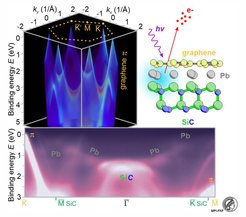An atom-thick lead crystal squeezed underneath epitaxial graphene
Momentum microscopy reveals the metallic nature of a two-dimensional Pb layer intercalated below charge-neutral quasi-freestanding graphene on SiC.
The stacking of two-dimensional (2D) layers is a promising path towards materials with novel electronic properties beyond conventional bulk systems. Epitaxial graphene on SiC is a versatile platform for stabilizing 2D forms of elements at its interface, which allows for modifying the properties of graphene as well as studying the properties of the 2D-intercalant element itself. For the 2D Au and Ag intercalated layers, it was found that they form strongly dispersing bands, which can be modeled by a simple 2D triangular lattice tight binding model and also, they turn out to be semiconducting as opposed to their bulk forms. In their recent study published in Physical Review Research, the Interface Analysis Group of the Max Planck Institute for Solid State Research in Stuttgart (MPI-FKF), has demonstrated the synthesis of an otherwise unstable, one-atom-thick layer of lead (Pb) by confining it in between epitaxial graphene and SiC.

For the past few years, there has been a great deal of interest in Pb as an intercalant for epitaxial graphene, because of the possible proximity effects from Pb such as superconductivity and spin-orbit coupling. However, previous reports lacked a uniform intercalation scenario and any information about the electronic structure of 2D-confined, intercalated Pb. Now, for the first time, the distinct electronic structure immanent to a well-ordered 2D crystal of Pb at the graphene/SiC interface is directly visualized and its metallic character is demonstrated – a significant result providing strong indication that the superconducting nature of bulk Pb may remain intact also in its 2D confined form. Concurrently, the controlled and uniform intercalation of Pb atoms at the interface renders epitaxial graphene practically charge neutral with any single excess charge carrier shared between almost a million of carbon atoms – a possible key to boost the carrier mobility in this material system. The homogeneous 2D stacking further bears the potential to mediate vertical proximity coupling: graphene could inherit the superconducting properties of its intercalant or even strong spin-orbit interaction owing to the huge atomic weight of Pb. Ulrich Starke, head of the Scientific Facility for Interface Analysis at MPI-FKF is therefore optimistic: “Foundations have been laid to harvest exciting quantum properties of a 2D heavy-element superconductor squeezed in at the graphene/SiC interface”.
The authors used the well-established technique of angle-resolved photoelectron spectroscopy (ARPES) to visualize the electronic structure of the graphene/2D-Pb/SiC system. ARPES measurements were carried out at a photon energy of 21.22 eV (non-monochromatized, unpolarized HeI α photons) by means of an energy-filtered photoemission electron microscope (PEEM) operating at an extractor voltage of 12 kV and at a nominal energy resolution of 0.1 eV (NanoESCA, Scienta Omicron GmbH). A momentum-space field of view of 4.3 Å−1 was used, giving access to the entire first surface Brillouin zone in a single-shot-type experiment without the need for any sample repositioning. ARPES constant energy cuts were acquired from a sample surface spot of ≈ 20 × 15 μm2 size as defined by an iris aperture and stacked together, thus providing the crown-like π-band structure including all six Brillouin zone corners of graphene. “The NanoESCA momentum microscope has really paid off in terms of the electronic structure survey of intercalated epitaxial graphene and it could also provide added value regarding the entire diverse portfolio of nanoscale materials investigated at MPI-FKF”, Ulrich Starke explains.











